
White fence separates the stage space from the ark of the covenant,
seven candles, and twelve vessels - Freemasonry Scottish Rite.
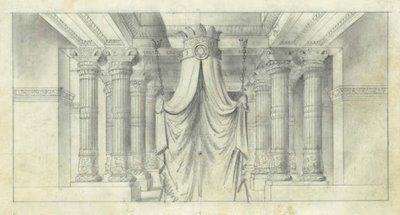
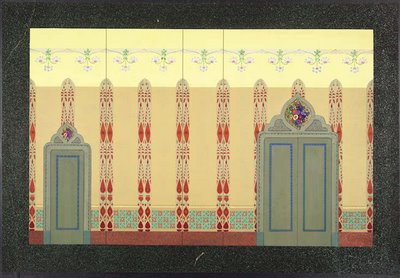
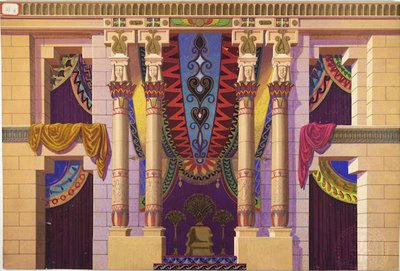
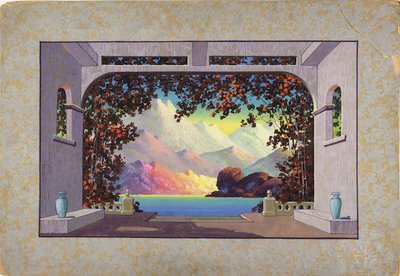
color theme is similar to the illustration by Maxfield Parrish, titled “Daybreak.”
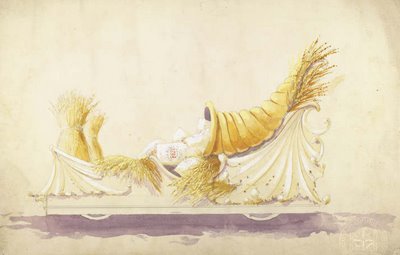
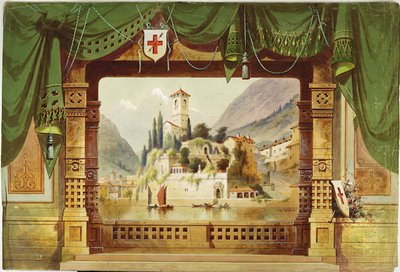
Titled, 'Belagona Castle, Switzerland'
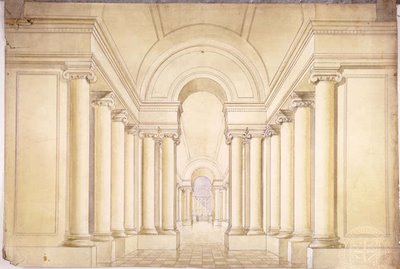
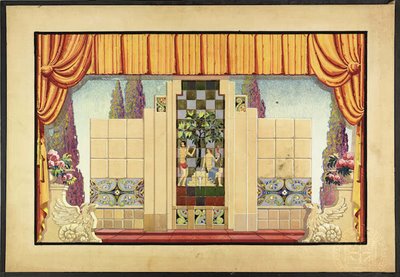
type block wall by Gilboe on cardboard.

Evening sky depicts the Morning star (Jupiter), the North
Star, and the seven stars of the Great Bear.

curtain with a seascape. Titled, 'Venice' 1923
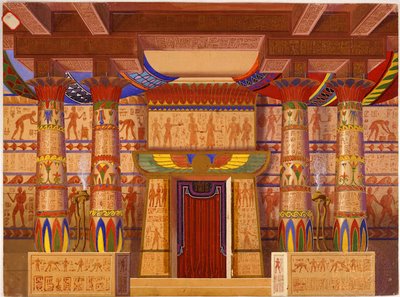
"The Performing Arts Archives holds a very rich collection of scenic backdrop renderings. It consists of watercolor renderings for theatre and Masonic drops which were created in the studios of Twin Cities Scenic Design Studios, Minneapolis, and the Great Western Stage Equipment Co., Kansas City, Missouri. The Holak Collection contains more than 180 renderings of drops for Scottish Rite temples and may be the most important of its kind. All told, there is a total of almost 1500 drawings in these beautiful and fascinating collections."Actually, there are over 2000 records in the database. It is a decidedly odd collection. The great majority of material relates to Masonic Lodges or initiation degrees and rites in freemasonry... as reflected in theatre sketches from the early 20th century (?!). Also strange was how often the word 'asbestos' came up in the notes or in the actual images.
In keeping with the odd flavour of the material is the over-instructive landing page for the University of Minnesota Scenic Collections Database. Click the 'Skip Instructions..' link. Then, for the easiest way to browse, click 'Find All Records' and click 'Next' when the 3 thumbnail results come up. Then go into the resulting URL in the address bar and change the number after "max=" from 3 to any number you want. I found it easiest to coast through the collection with 500 thumbnail images per page. [All notes below the images here are quoted from the site]
Addit: Actually this is the landing page with links to background notes that help explain the context of the material. For instance:
"The rise of fraternal orders and societies in this country was phenomenal during the late 1800s; more than 6 million Americans had become members by 1907. These societies were formed to study social issues, to promote certain political viewpoints, or to provide philanthropic frameworks for the distribution of financial aid to their members.Surprisingly, some of the biggest of these organizations arose out of the theatrical community. For instance, the Benevolent and Protected Order of Elk grew out of an association of New York minstrel players and managers, while the Fraternal Order of the Eagle was initially a coalition of theatre producers who joined together to fight the musicians' union. It may have been these ties to the theatre that led many societies to create elaborately costumed and staged initiation rituals."
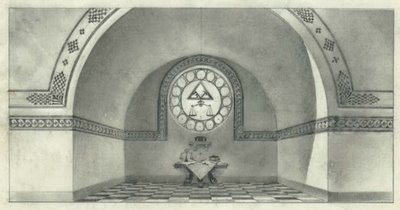










































5 comments :
whoa ! fantastic!!thanks to post it! I love sketches scene (we can build some in little box ) post an other link about it on 19 September .
;-))
Thanks for this entry. As a theater worker who finds himself drawn to Masonic imagery, these pictures were a great find.
As for the term "asbestos" appearing so often, that may refer to the curtains being "fire curtains" or fire retardant. Fire curtains are an emergency measure made to drop between stage and audience in the event of a stage fire. Better to kill the actors than the paying customers.
I've never heard of a decorative fire curtain, so I would assume that these curtains were just less likely to catch fire than the non-asbestos version.
Many thanks for a site I visit daily.
Pure backdrop gold, Pecay!
(Yes, I'm a scenic designer)
Just found this great reference while searching for something else! What's new?!
The Asbestos reference is very simple. The fire curtain that separates the stage from the auditorium is sometime refred to as the 'Iron' if made with steel sheet covering or the 'Asbestos' if the frame is faced with asbestos cloth. Such material is no longer used for health reasons.
In times of easily combustible cloth and timber framed scenery this was a necessary, but often forgotten item of safety equipment. Even when such an item was installed it could be ignored as in the Iroquois Theatre fire of 30 December 1903 when its descent was blocked.
The Chicargo and other tragedies made made Theatre Managers think. Some publicised the fact they had a Safety Curtain and it was in working order. To show this, it would be dropped in the Intermission. However, most wanted their Asbestos or Iron enlivened so as not be a negative reminder of tragedy and turned to scenic artists to beautify matters.
In some cases advertising space around the sides and bottom was sold to raise income. Later the central picture was often painted over to provide a screen for projected advertising of future productions or seasonal products.
Aaah!, thanks wkt -- I had to cast my mind back a long way to recall what I was thinking about. But it all makes perfect sense. Fabulous collection of course.
Post a Comment
Comments are all moderated so don't waste your time spamming: they will never show up.
If you include ANY links that aren't pertinent to the blog post or discussion they will be deleted and a rash will break out in your underwear.
Also: please play the ball and not the person.
Note: only a member of this blog may post a comment.